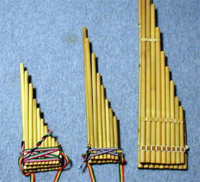.gif)
Siku (panpipe)
Encyclopedia

Aymara language
Aymara is an Aymaran language spoken by the Aymara people of the Andes. It is one of only a handful of Native American languages with over three million speakers. Aymara, along with Quechua and Spanish, is an official language of Peru and Bolivia...
speaking regions around Lake Titicaca. Historically because of the complicated mountain geography of the region, and due to other factors, in some regions each community would develop its own type of siku, with its own special tuning, shape and size. Additionally each community developed its own style of playing. Today the siku has been standardized to fit in with modern western forms of music and has been transported from its traditional roots.
History Of The Original Siku
The Siku (Panpipe) is originally from the Aymaras of Perú - Bolivia, where woman would play their siku as they came down from the mountains. Since the largest siku has every note (A-G), and was too big for the woman,they often got two sikus (usually smaller ones) that would be played together with someone else, so they could play them continuously after each other and thus the scales could fully be played. Once the women partnered, they then became musically bonded with each other, as part of their religion, and neither could play the pipes with any other for the rest of their life.Women would also assemble into groups as they came down the mountains, each group would play different tunes, and as they got together, they would blend all the melodies together to create one complete melody. The woman also played the siku to attract wild goat that they would then harvest.
Design
Sikus are typically made from bambooBamboo
Bamboo is a group of perennial evergreens in the true grass family Poaceae, subfamily Bambusoideae, tribe Bambuseae. Giant bamboos are the largest members of the grass family....
shoots, but have also been made from Condor feathers, bone, and many other materials. Additionally, different types of bamboo are employed to change the quality of the sound. Songo, or shallow-walled bamboo, gives a louder, more resonant sound than regular deep-walled bamboo, but is less common due to its fragility.
Siku is split across two rows of pipes. One must alternate rows with every note in order to play a complete scale. Traditionally, two musicians were required to play the siku, each one taking one row of the instrument. One part of instrument is called ira, another arka. It is considered that spiritually ira corresponds to male principle and arka to female. When many musicians divide in two parts, first playing ira and second playing arka, this gives Andean music a distinctive stereophonic sound
Stereophonic sound
The term Stereophonic, commonly called stereo, sound refers to any method of sound reproduction in which an attempt is made to create an illusion of directionality and audible perspective...
. Hear example.
Now it is more common to see one musician playing both rows of the instrument together, but rustic ensembles retain traditional playing.
Varieties
The most widespread variety of siku, siku ch'alla, contains 13 pipes (6 in ira and 7 in arka), but less common varieties may have more and less pipes. Some of them employ extra open-ended reeds attached to the front of the instrument to change the sound quality. The Tabla Siku has all of the pipes cut to the same length, so the instrument is rectangular in shape, but has stoppers inside the tubes to adjust the actual resonant length of the chambers.Scale and tuning

The Siku uses a diatonic scale. Siku ch'alla is tuned in E minor / G major, arca: D-F#-A-C-E-G-B and ira:E-G-B-D-F#-A.
There are a contemporary varieties of siku with chromatic scale having 3 rows, with pitch distribution similar to chromatic button accordion
Chromatic button accordion
A chromatic button accordion is a type of button accordion where the melody-side keyboard consists of rows of buttons arranged chromatically. The bass-side keyboard is usually the Stradella system or one of the various free-bass systems. Included among chromatic button accordions are the Russian...
.
Sizes


